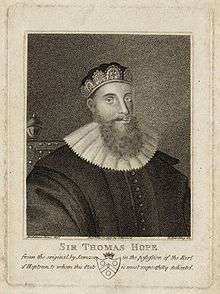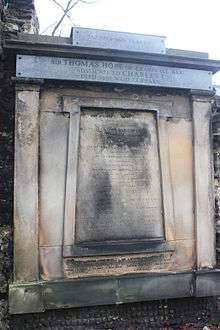Sir Thomas Hope, 1st Baronet
Sir Thomas Hope, 1st Baronet Hope of Craighall (1573–1646) was a Scottish lawyer, and Lord Advocate under Charles I.

_(14762795682).jpg)

Life
He was the son of an eminent Edinburgh merchant, Henry Hope, and his French wife, Jacqueline de Tott.[1]
Admitted as an advocate in 1605, he made his reputation in 1606 defending John Forbes, and five other ministers at Linlithgow who were charged with high treason.[2] He prepared the deed revoking James VI's grants of church property in 1625. He was appointed Lord Advocate under Charles I in 1626, and held the office until 1641. He was created a Baronet of Nova Scotia on 11 February 1628.[1]
Hope worked for landowners, like Mary, Countess of Home.[3] He conducted the case against John Elphinstone, 2nd Lord Balmerino in 1634. As Lord High Commissioner to the General Assembly of the Church of Scotland in 1643, he maintained the king's temporising policy.
In 1645 Hope was appointed one of the Commissioners for managing the Exchequer, but died the next year.
He is buried in Greyfriars Kirkyard in Edinburgh.[4] The grave lies in the north-west section of the original graveyard, against the west wall.
His Cowgate home, built in 1616, was demolished in 1887 to make way for the Edinburgh Free Library.[5][6]
Related Works
His "Practical Observations Upon divers titles of the Law of Scotland", commonly called the "Minor Practicks", were published in 1726, by Alexander Bayne.[7][8]
In 1843 the Bannatyne Club published A Diary of the Public Correspondence of Sir Thomas Hope of Craighall, 1633–1645: From the Original, in the Library at Pinkie House, a collection Hope's official and private correspondence from the last twelve years of his life.[9]
Family
Hope married Elizabeth Bennet,[10] daughter of John Binning or Bennet of Wallyford, Haddingtonshire. The couple had the following children:[11]
- John Hope, Lord Craighall (1605?–1654)
- Thomas Hope, Lord Kerse (1606–1643)
- William, died young
- Henry, died young
- Sir Alexander Hope of Grantham/Granton (1611–1680), Carver Extraordinary[12] and cup-bearer to Charles I.[13][14]
- Sir James Hope of Hopetoun (1614–1661), progenitor of the Earls of Hopetoun[14]
- David, died young
- Patrick, died young
- Charles, died young
- Elizabeth, died young
- Margaret, died young
- Mary/Marie, married Sir Charles Erskine, 1st Baronet of Alva[14]
- Elizabeth, died unmarried
- Anne/Anna, married David Erskine, 2nd Lord Cardross
Of the four sons who survived infancy, three of these later qualified as advocates: John, Thomas and James.[15] Two of these sons were elevated to judges in the Supreme Court.
Two of his sons were appointed to the bench while Hope was Lord Advocate; and it being judged by the Court of Session unbecoming that a father should plead uncovered before his children, the privilege of wearing his hat, while pleading, was granted to him. This privilege his successors in the office of Lord Advocate have in theory ever since enjoyed.
Historical fiction
- Sir Thomas Hope is the subject of Nigel Tranter's last novel, Hope Endures (2005).
References
- John Burke (1838). "A Genealogical and Heraldic History of the Commoners of Great Britain and Ireland, Enjoying Territorial Possessions Or High Official Rank: But Univested with Heritable Honours, Volume 4". Great Britain. pp. 458–459. Retrieved 28 May 2017.
- Monuments and monumental inscriptions in Scotland: The Grampian Society, 1871
- A Diary of the Public Correspondence of Sir Thomas Hope of Craighall, 1633–1645: From the Original, in the Library at Pinkie House (Bannatyne Club: Edinburgh, 1843), p. 10.
- Monuments and monumental inscriptions in Scotland: The Caledonian Society of Scotland
- "Visitors to the Site of the Free Library". Scotland: Edinburgh Evening News, Midlothian, Scotland. 23 March 1887.
- Robert Chambers, John Gibson Lockhart, R. L. Stevenson (27 November 2014). The Edinburgh Collection: Traditions of Edinburgh , Peter's Letters to his Kinfolk, Edinburgh: Picturesque Notes. Palimpsest Book Production Limited.CS1 maint: multiple names: authors list (link)
- Stephen, Leslie, ed. (1885). . Dictionary of National Biography. 3. London: Smith, Elder & Co.
- Sir Thomas Hope (1726). Minor Practicks: Or, A Treatise of the Scottish Law. T. Ruddiman and sold by W. Monro. Retrieved 13 July 2017.
- A Diary of the Public Correspondence of Sir Thomas Hope of Craighall, 1633–1645: From the Original, in the Library at Pinkie House. Great Britain: Bannatyne Club. 1843. Retrieved 13 July 2017.
- https://archive.org/stream/registerinterme00socigoog/registerinterme00socigoog_djvu.txt
- Sir James Balfour Paul, (1846–1931) (1907). Douglas, David (ed.). The Scots peerage : founded on Wood's ed. of Sir Robert Douglas's Peerage of Scotland; containing an historical and genealogical account of the nobility of that kingdom. Edinburgh, Scotland. pp. 484–505. Retrieved 28 May 2017.
- Sir Thomas Hope (1893). Twenty-four Letters, 1627–1646. Scotland: Scottish History Society. pp. 82–83.
- John Philip Wood (1794). Antient and Modern State of the Parish of Cramond. J. Paterson. p. 19. Retrieved 28 May 2017.
- Sir Robert Douglas (1798). The Baronage of Scotland. Edinburgh, Scotland. pp. 58–61. Retrieved 23 July 2017.
- Lee, Sidney, ed. (1891). . Dictionary of National Biography. 27. London: Smith, Elder & Co.
- Attribution
![]()
External links
| Legal offices | ||
|---|---|---|
| Preceded by Sir William Oliphant |
Lord Advocate 1626–1641 |
Succeeded by Sir Archibald Johnston |
| Baronetage of Nova Scotia | ||
| New creation | Baronet (of Craighall) 1628–1646 |
Succeeded by John Hope |